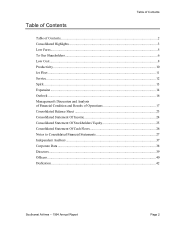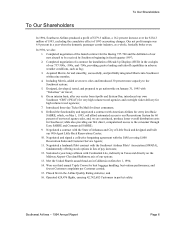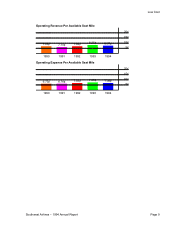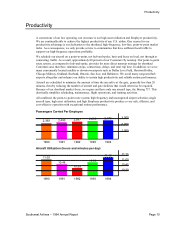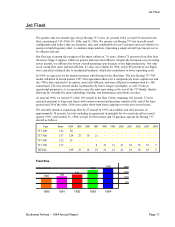Southwest Airlines 1994 Annual Report Download - page 11
Download and view the complete annual report
Please find page 11 of the 1994 Southwest Airlines annual report below. You can navigate through the pages in the report by either clicking on the pages listed below, or by using the keyword search tool below to find specific information within the annual report.
Jet Fleet
Southwest Airlines – 1994 Annual Report Page 11
Jet Fleet
We operate only one aircraft type, the jet Boeing 737 series. At yearend 1994, we had 199 aircraft in the
fleet, consisting of 124 -300s; 50 -200s; and 25 -500s. We operate our Boeing 737 jets in an all-coach
configuration and believe they are attractive, safe, and comfortable for our Customers and cost-effective to
operate in high-frequency short- to medium-range markets. Operating a single aircraft type has proven to
be efficient and safe.
Our fleet age is among the youngest of the major airlines at 7.6 years. Almost 75 percent of our fleet have
the newer Stage 3 engines, which are quieter and more fuel-efficient. Despite the increased cost of owning
newer aircraft, we still have the lowest overall operating costs because of our high productivity. Not only
is our young fleet quiet and fuel-efficient, it’s also very reliable. In 1994, only 0.86 percent of our flights
were canceled or delayed due to mechanical incidents, which also contributes to lower operating costs.
In 1994, we agreed to be the launch customer with Boeing for the third time. The new Boeing 737-700
model will debut in fourth quarter 1997. Our agreement allows for a comparatively lower capital cost and
the -700 is also expected to be quieter, more fuel-efficient, and more efficient to maintain than its -300
counterpart. The new aircraft model is planned to fly faster, longer, and higher, as well. From an
operational perspective, it is expected to carry the same type rating as the rest of the 737 family, thereby
allowing for virtually the same scheduling, training, and maintenance operations as today.
At yearend 1994, we owned 97 of the 199 aircraft in the fleet. Of the remaining 102 aircraft, 72 were
operated pursuant to long-term leases with various renewal and purchase options at the end of the lease
periods and 30 of the older -200s were under short-term leases expiring over the next several years.
We currently intend to expand our fleet by 27 aircraft in 1995, an available seat mile increase of
approximately 14 percent. In total, including an agreement in principle for two used aircraft in second
quarter 1995, at December 31, 1994, we had 118 firm orders and 74 purchase options for Boeing 737
aircraft as follows:
Type Seats 1994 1995 1996 1997 1998 1999 2000 2001 2002 2003 2004
737-200 122 50 – – – – – – – – – –
737-300 137 124 27 18 21 – – – – – – –
737-500 122 25 – – – – – – – – – –
737-700 137 – – – 4 21 21 21 18 18 18 5
TOTAL 199 27 18 25 21 21 21 18 18 18 5
Fleet Size
20
0
15
0
10
0
5
0
106
141
178 199
124
1
9
9
4
1
9
9
3
1
9
9
2
1
9
9
1
1
9
9
0


